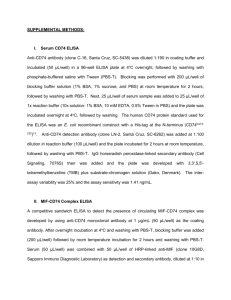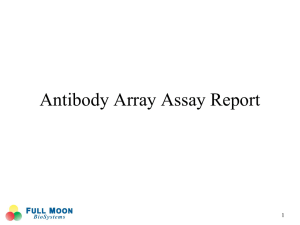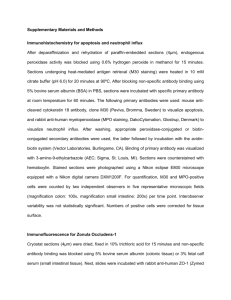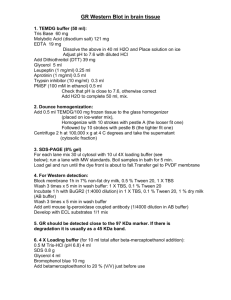Factor V antigen (FV)
advertisement
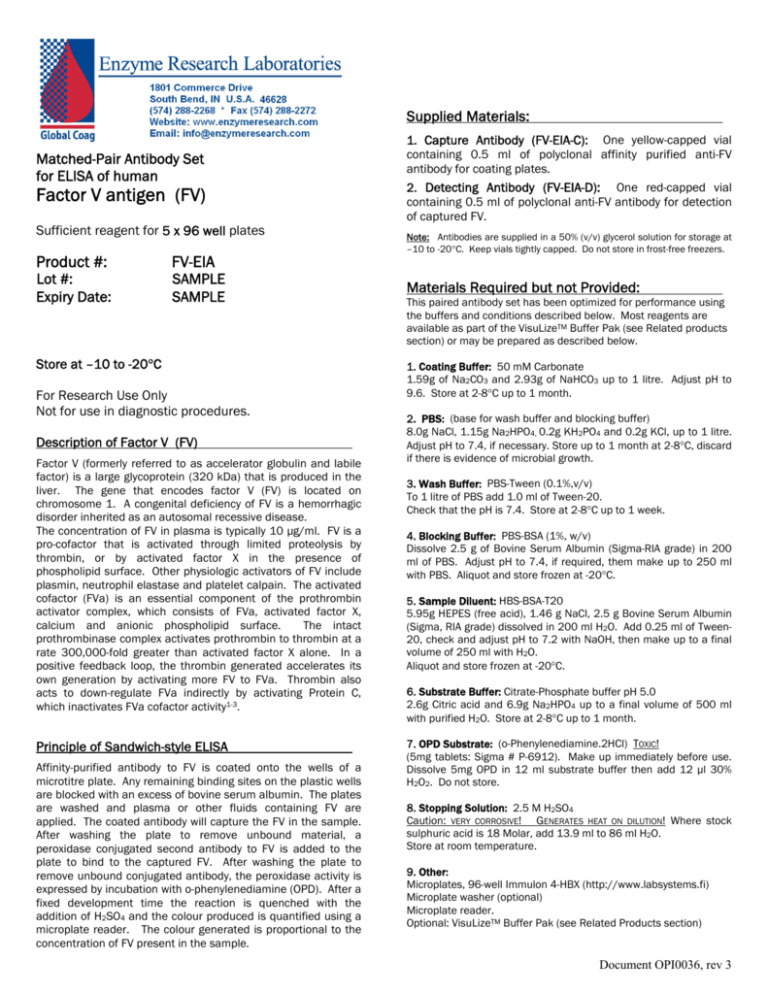
Supplied Materials: Matched-Pair Antibody Set for ELISA of human Factor V antigen (FV) Sufficient reagent for 5 x 96 well plates Product #: Lot #: Expiry Date: FV-EIA SAMPLE SAMPLE Store at –10 to -20°C For Research Use Only Not for use in diagnostic procedures. Description of Factor V (FV) Factor V (formerly referred to as accelerator globulin and labile factor) is a large glycoprotein (320 kDa) that is produced in the liver. The gene that encodes factor V (FV) is located on chromosome 1. A congenital deficiency of FV is a hemorrhagic disorder inherited as an autosomal recessive disease. The concentration of FV in plasma is typically 10 µg/ml. FV is a pro-cofactor that is activated through limited proteolysis by thrombin, or by activated factor X in the presence of phospholipid surface. Other physiologic activators of FV include plasmin, neutrophil elastase and platelet calpain. The activated cofactor (FVa) is an essential component of the prothrombin activator complex, which consists of FVa, activated factor X, calcium and anionic phospholipid surface. The intact prothrombinase complex activates prothrombin to thrombin at a rate 300,000-fold greater than activated factor X alone. In a positive feedback loop, the thrombin generated accelerates its own generation by activating more FV to FVa. Thrombin also acts to down-regulate FVa indirectly by activating Protein C, which inactivates FVa cofactor activity1-3. Principle of Sandwich-style ELISA Affinity-purified antibody to FV is coated onto the wells of a microtitre plate. Any remaining binding sites on the plastic wells are blocked with an excess of bovine serum albumin. The plates are washed and plasma or other fluids containing FV are applied. The coated antibody will capture the FV in the sample. After washing the plate to remove unbound material, a peroxidase conjugated second antibody to FV is added to the plate to bind to the captured FV. After washing the plate to remove unbound conjugated antibody, the peroxidase activity is expressed by incubation with o-phenylenediamine (OPD). After a fixed development time the reaction is quenched with the addition of H2SO4 and the colour produced is quantified using a microplate reader. The colour generated is proportional to the concentration of FV present in the sample. 1. Capture Antibody (FV-EIA-C): One yellow-capped vial containing 0.5 ml of polyclonal affinity purified anti-FV antibody for coating plates. 2. Detecting Antibody (FV-EIA-D): One red-capped vial containing 0.5 ml of polyclonal anti-FV antibody for detection of captured FV. Note: Antibodies are supplied in a 50% (v/v) glycerol solution for storage at –10 to -20°C. Keep vials tightly capped. Do not store in frost-free freezers. Materials Required but not Provided: This paired antibody set has been optimized for performance using the buffers and conditions described below. Most reagents are available as part of the VisuLizeTM Buffer Pak (see Related products section) or may be prepared as described below. 1. Coating Buffer: 50 mM Carbonate 1.59g of Na2CO3 and 2.93g of NaHCO3 up to 1 litre. Adjust pH to 9.6. Store at 2-8°C up to 1 month. 2. PBS: (base for wash buffer and blocking buffer) 8.0g NaCl, 1.15g Na2HPO4, 0.2g KH2PO4 and 0.2g KCl, up to 1 litre. Adjust pH to 7.4, if necessary. Store up to 1 month at 2-8°C, discard if there is evidence of microbial growth. 3. Wash Buffer: PBS-Tween (0.1%,v/v) To 1 litre of PBS add 1.0 ml of Tween-20. Check that the pH is 7.4. Store at 2-8°C up to 1 week. 4. Blocking Buffer: PBS-BSA (1%, w/v) Dissolve 2.5 g of Bovine Serum Albumin (Sigma-RIA grade) in 200 ml of PBS. Adjust pH to 7.4, if required, them make up to 250 ml with PBS. Aliquot and store frozen at -20°C. 5. Sample Diluent: HBS-BSA-T20 5.95g HEPES (free acid), 1.46 g NaCl, 2.5 g Bovine Serum Albumin (Sigma, RIA grade) dissolved in 200 ml H2O. Add 0.25 ml of Tween20, check and adjust pH to 7.2 with NaOH, then make up to a final volume of 250 ml with H2O. Aliquot and store frozen at -20°C. 6. Substrate Buffer: Citrate-Phosphate buffer pH 5.0 2.6g Citric acid and 6.9g Na2HPO4 up to a final volume of 500 ml with purified H2O. Store at 2-8°C up to 1 month. 7. OPD Substrate: (o-Phenylenediamine.2HCl) TOXIC! (5mg tablets: Sigma # P-6912). Make up immediately before use. Dissolve 5mg OPD in 12 ml substrate buffer then add 12 µl 30% H2O2. Do not store. 8. Stopping Solution: 2.5 M H2SO4 Caution: VERY CORROSIVE! GENERATES HEAT ON DILUTION! Where stock sulphuric acid is 18 Molar, add 13.9 ml to 86 ml H2O. Store at room temperature. 9. Other: Microplates, 96-well Immulon 4-HBX (http://www.labsystems.fi) Microplate washer (optional) Microplate reader. Optional: VisuLizeTM Buffer Pak (see Related Products section) Document OPI0036, rev 3 Assay Procedure: Technical Notes: 1. Coating of plates: Dilute the capture antibody 1/100 in coating buffer (preferably in a polypropylene tube) and immediately add 100 µl to every well in the plate. Incubate overnight @ 4oC. - This paired antibody product is intended to facilitate the end user in establishing an in-house immunoassay for research purposes only. It must not be used for diagnostic applications. Assay validation is the responsibility of the end user and should be done according to user-defined protocols6. - Reference calibrators should be of the same matrix and anticoagulant as the samples to be tested (example serum or plasma, citrate or EDTA) - Do not use samples diluted less than 1/10, as falsely high readings may result. - The optimal colour development time should be determined empirically as the time required to obtain an absorbance of at least 1.000 at 490 nm for the 100% reference point, not to exceed 20 minutes. - Rheumatoid factor in samples may interfere in ELISA by binding to the capture and/or detecting antibodies. - The wells should not be allowed to become dry. Keep plate covered or in a humid chamber during incubations. - Antibodies are supplied in a 50% glycerol solution and can be centrifuged briefly in a micro-centrifuge to gather residual reagent from the cap and walls of the tube. 2. Blocking: Empty contents of plate and add 150 µl of blocking buffer to every well and incubate for 90 minutes @ 22oC. Wash plate X 3 with wash buffer. 3. Samples: Reference plasma is diluted 1/200 (100%) then serial 1/2's down to 1/6400 (3.13%). Sample plasmas are diluted 1/400, 1/800 & 1/1600. All dilutions are made in HBS-BSAT20 sample diluent. Apply 100 µl/well and incubate plate @ 22oC for 90 minutes. Wash plate X 3 with wash buffer. 4. Detecting Antibody: Dilute the detecting antibody 1/100 in HBS-BSA-T20 sample diluent and apply 100 µl to each well. Incubate plate @ 22oC for 90 minutes. Wash plate X 3 with wash buffer. 5. OPD Substrate: Apply 100 µl of freshly prepared OPD substrate to every well. Allow colour to develop for 10-15 minutes then stop colour reaction with the addition of 50 µl/well of 2.5 M H2SO4. The plate can be read at wavelength of 490 nm. Calculation of Results: The construction of a proper reference curve is of no less importance than any other aspect of the assay. A reference curve should be constructed by plotting the known concentration of standards versus absorbance. This can be done manually using graph paper, or by using curve-fitting computer software. In our experience, the dose response curves of most immunoassays tend to be sigmoid in shape. Although linear regions can be identified within the curve, the best overall fit is often obtained using an algorithm that provides a weighted theoretical model of fit throughout the entire curve, such as a 4-parameter or 5-parameter logistic curve fit 4,5. In general, the simplest model that defines the concentration-response relationship should be used 6. The “back-fit” test is a simple and reliable method to determine if a curve-fitting method is appropriate. In this test, the apparent concentrations for the absorbance values of each standard point are read from the reference curve. The derived values are compared to the assigned values. An appropriate curve fitting method will produce derived values that closely match assigned values throughout the range of the curve, within user-defined 2 limits6. The coefficient of determination (R ) is a valuable indicator of the overall fit, but should not be used by itself in the selection of a curve fitting method, as a poor fit in a particular region of the curve may not be evident from this value alone 5,6 In the quality control of this product we have determined that under the conditions described above, a reference curve that is constructed using serial dilutions of normal pooled plasma, will 2 produce a correlation coefficient (R ) of at least 0.980 using a log2 log fit, and an R of at least 0.990 using a 4-parameter logistic curve fit algorithm. However, the performance characteristics of inhouse assays developed using this product in other laboratories may vary slightly from ours. Different curve fitting methods may be employed but we recommend that the back-fit test be applied as evidence that the fitting method is appropriate. References: 1. Kane WH, Davie EW; Blood Coagulation Factors V and VIII: Structural and functional similarities and their relationship to hemorrhagic and thrombotic disorders. Blood 71:539, 1988. 2. Hoyer, LW, Wyshock EG, Colman RW, in Hemostasis and Thrombosis, 3rd Edition, eds. RW Colman, J Hirsh, VJ Marder and EW Salzman, pp. 109-133, J.B. Lippincott Co., Philadelphia, 1994. 3. Nesheim ME, Katzmann JA, Tracy PB, Mann KG; in Methods in Enzymology 80:249, 1980. 4. Nix,B, Wild D, in Immunoassays, A Practical Approach, editor J.P. Gosling, pp. 239-261, Oxford University Press, 2000. 5. NCCLS. Evaluation of the Linearity of Quantitative Analytical Methods; Proposed Guidline – Second Edition. NCCLS Document EP6-P2 (ISBN 156238-446-5, NCCLS, Wayne, Pennsylvania USA, 2001. 6. FDA Guidance for Industry. Bioanalytical Method Validation; May 2001, available on the internet: www.fda.gov/cder/guidance/index.htm Related Products: Cat #: Cat #: Cat #: Cat #: Cat #: Cat #: Cat #: Cat #: Cat #: Cat #: Cat #: Cat #: EIA-PAK-1 SAFV-IG SAFV -AP SAFV -HRP SAFV-APFTC SAFV-APBIO SABFV-IG SABFV -AP SABFV -HRP FV-DP INH5-DP INH5-LDP VisuLizeTM Buffer Pak, 5 plates, buffers, substrate Sheep anti-human FV, whole IgG from antiserum Sheep anti-human FV, affinity purified IgG (APIgG) Sheep anti-human FV, IgG-peroxidase conjugate Sheep anti-human FV, FITC conjugated APIgG Sheep ant-human FV, Biotinylated APIgG Sheep anti-bovine FV, whole IgG from antiserum Sheep anti-bovine FV, affinity purified IgG Sheep anti-bovine FV, IgG-peroxidase conjugate Plasma deficient in FV, immune depleted Factor V Inhibitor Plasma, frozen Factor V Inhibitor Plasma, lyophilized Document OPI0036, rev 3

